Mahameda Uses, Medicinal Qualities, Remedies, Research
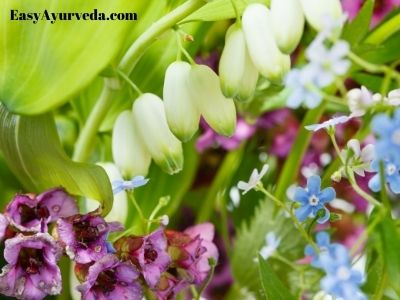
By Dr Renita D’Souza
Mahameda (Polygonatum cirrhifolium (Wall.) Royle) is an Ayurvedic herb which is mentioned as one among the Ashtavarga herbs, an Ayurvedic formulation with 8 strength promoting herbs. Traditionally, the rhizomes of this plant are used to increase the physical strength, nourish the body tissues, acts as aphrodisiac, rejuvenative and galactagogue.
Botanical Name – Polygonatum cirrhifolium (Wall.) Royle
Synonyms – Convallaria cirrhifolia Wall
Family – Liliaceae
Read – Meda (Polygonatum verticillatum) Uses, Qualities, Remedies, Research
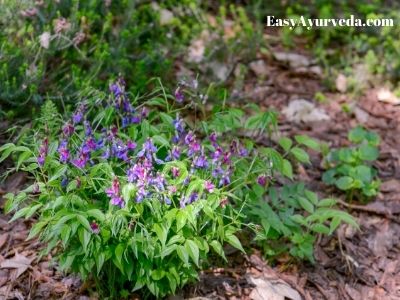
Table of Contents
Vernacular Names
English Name – King’s Solomon’s Seal, Tendril leaf Solomon’s seal, Coiling leaf Solomon’s Seal. Coiling leaf Polygonatum.
Sanskrit Name – Mahameda
Hindi Name – Mahameda, Devarigaala
Tamil Name – Mahameda
Malayalam Name – Mahameda
Telugu Name – Mahameda
Kannada Name –Mahamedha
Medicinal Qualities
Taste (Rasa) – Sweet
Potency (Virya) – Cold
Post digestion taste (Vipaka) – sweet
Qualities (Guna)
Guru – heavy to digest
Action (Karma) –
Vrishya – Aphrodiasiac
Sthanyakrit – increases breast milk
Brihmana – nourishes the body tissues
Shukra vivardana – increases semen
Ruchya – appetizer
Effect on Doshas
Balances aggravated Pitta and Vata dosha
Aggravates Kapha dosha
Read – Jeevaneeya Gana Herbs of Charaka: Review, Medicines, Benefits
Therapeutic Uses
Burning sensation
Bleeding disorders
General debility (Kshaya)
Fever due to vata dosha
Cough
Anorexia
Wound
Emaciation
Gout
Seminal disorders
Bronchitis
Tuberculosis
Part Used
Rhizome
Dosage
Rhizome powder – 2- 3 grams or as directed by the physician
Sanskrit Verses
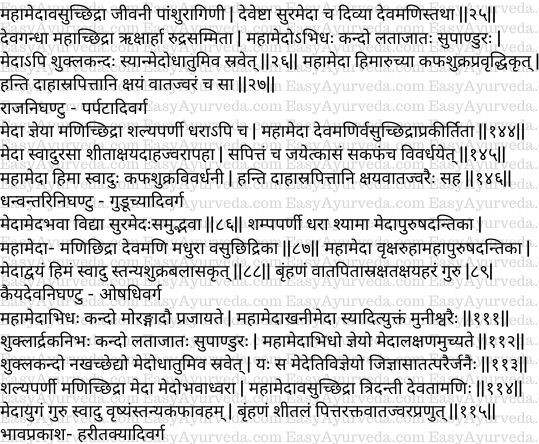
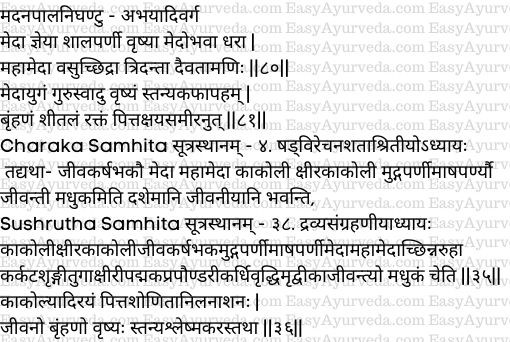
Remedies
Aphrodiasiac, Blood purifier – Mahameda root infusion with made with milk and consumed is used as folklore medicine. Its utility varies in different places.
Read – Ashtavarga Group Of Herbs Benefits, Research
Pharmacological Activities
Polygonatum cirrhifolium possess Antioxidant, Hypoglycemic, Hypotensive, Antibacterial and Antifungal activities.
Botanical Description
Polygonatum cirrhifolium is a perennial herb grows up to the height of 20 -120 cm. Stem is unbranched, weak and glabrous. Leaves are 3-6 arranged in whorls, sessile and linear in shape. Flowers are pendulous, white greenish or purple in color, stamens – 6 inserted in the middle of the tube. Fruits are globose, green and turns orange red on ripening.
Bhavapraksha Nighantu described rhizome of Mahameda as pale white in color resembling like ginger. Grows in Moranga (South East part of Nepal). The plant is also called by the name “Vani meda”.
Read – Jeevaka (Microstylis wallichii) Uses, Medicinal Qualities, Remedies, Research
Distribution
Polygonatum cirrhifolium is found in Northern Asia, China, Nepal, Bhutan, Pakistan and in India it is found in temperate Himalayas, Himachal Pradesh, Sikkim, Manipur and Uttarakhand.
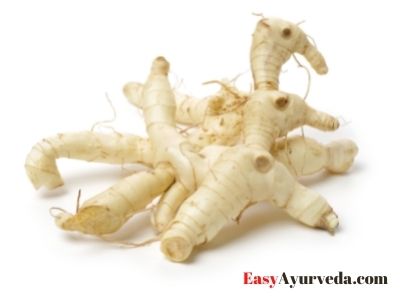
Substitutes
Satavari (Asparagus racemosus), Nagbala (Sida veronicifolia Lam.), Shakakul mishri (Polygonatum multiflorum) and Prasarani (Paederia foetida Linn.) are used as substitutes of Mahameda.
Chemical Constituents
Polygonatum cirrhifolium contains α-L-rhamnopyranosyl, β-Dglucopyranoside, dauvosterol, β-sitosterol, 6- nonadecenoic acid, 6-stearic acid and one inorganic compound.
Nutritional Values
Polygonatum cirrhifolium rhizomes are rich in starch, protein, pectin and asparagine.
Research
A research study ” Ferulic Acid and Maleamic Acid – The Probable Scientific Basis of Pairing of Meda-Mahameda (Polygonatum cirrhifolium andP. verticillatum) Couplets” investigated that presence of maleamic acid in both plants Meda and Mahamedais is the bases for pairing of these plants. (Read more)
Sanskrit Synonyms
Vasuchidra, Tridanti, Devatamani, Manichidra, Devamani, Madhura, Vasuchidraka,
Vriksharuha, Mahapurushadantika, Jivani, Pamshuragini, Deveshta, Surameda, Divya, Devamani, Devagandha, Mahachidra, Rkshaarha, Rudrasamita.
Classical Categorization
Bhavaprakasha Nighantu – Harithakyadi Varga
Kaiyadeva Nighantu – Oshadivarga
Dhanvantari Nighantu – Guduchyadi varga
Raja Nighantu – Parpataadi varga
Madanapala Nighantu – Abhayadi varga
Charaka Samhita – Included Mahameda under Jeevaniyaani dashemaani.
Sushruta Samhita – Included Mahameda under Kakolyaadi ghana.
Read – Shukrajanana Gana: Herbs To Improve Semen, Sperm: Review, Formulations

Formulations
Chyavanprash
Dasamoolarishtam
Dhaanwantharam mezhukupaakam – Used to treat vata diseases, paralysis, tissue depletion, pediatric problems etc.
Bruhath Chandanaadi Thailam
Prasoothika Kahayam – Used after delivery for restoring health
Amruth jeevan rasayan – Used in fatigue, low immunity etc
Brihat ashwagandha Ghrita – Used in oligospermia, infertility etc
Madhuyashtyadi taila – Best used in pitta related diseases such as fever and burning sensation
Shatavaryadi ghrita
Brihat Chagaladya Ghrita – Used to treat all types of Vata diseases
Vasachandanadi taila
Dhanwantharam thailam – Widely used to treat spondylosis, arthritis and neuro muscular conditions
Mahanarayan oil – Used in arthritis, paralysis and other vata diseases
Kamdev Ghrita – Used as aphrodisiac, rejuvenative, improves sperm count, body strength and skin complexion.
Artilon Soft Gel – Used in osteoarthritis
Dhanwantharam Kashayam – Used in post natal care of mother
Shiva gutika – Used in liver and spleen disorders
Scientific Classification
Kingdom – Plantae
Division – Tracheophyta
Class – Liliopsida
Order – Liliales
Family – Liliaceae
Genus – Polygonatum
Species – cirrhifolium
Click here to consult Dr Renita D’Souza









